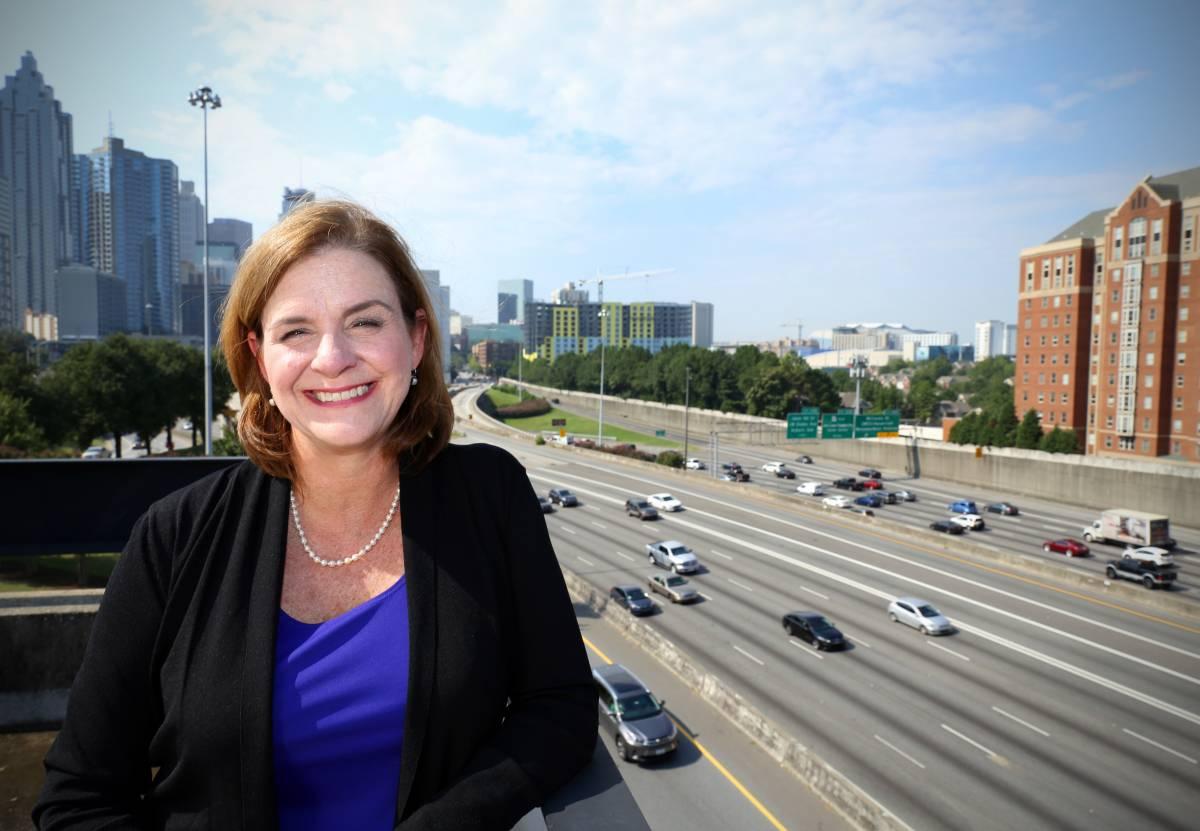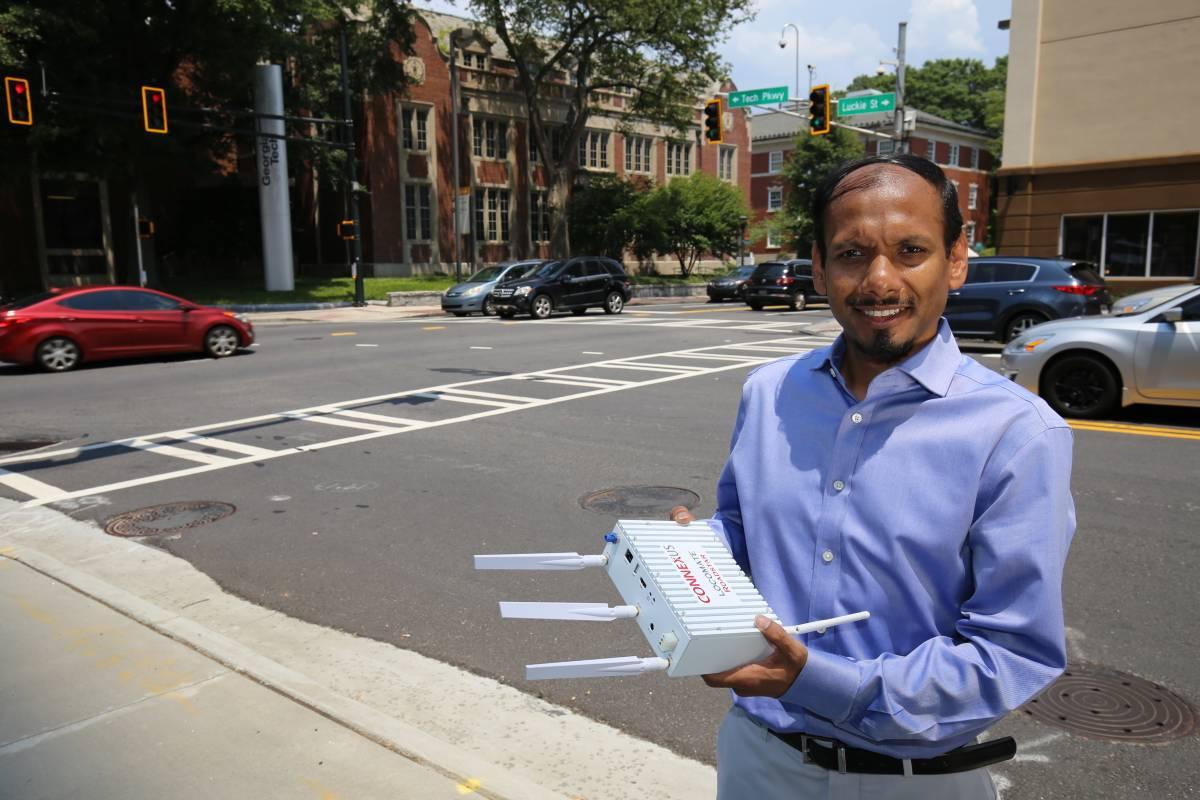Three engineers work to speed mobility – and slow an obstacle to growth

We’ve all been there. Driving along at posted speed, or a little above, coming up on the lights. Red. They could be traffic signals or brake lights; we might have spied them in the distance or been surprised at the bend. And then we are stopped. Then we move a little. Then stop. Move. Stop. Wait.
Science has not rendered a full picture of what happens to us when we engage in this sequence again and again. But studies show it takes a toll — respiratory ailments, mental stress, even incidence of domestic violence. What is certain is that time in traffic is forever lost. To be stuck is to surrender minutes in a commute, hours in a week, days in a year, weeks and months in a lifetime.
And it’s an oddly deceptive experience. Three out of four of us are alone in the vehicle. Traffic is about the masses, but it feels solitary. In reality, road congestion is the product of exquisite interconnectedness and interdependence: What happens in one place affects all the others.
That perfectly describes what it’s like to solve traffic congestion, too. From vast highway projects to the placement of a single sign — and all the strategy and policy in between — reducing congestion requires minds that can break apart a problem and work through complexity. In other words, the minds of good engineers.
Tech engineers Meg Pirkle, Jacob Tzegaegbe and Angshuman Guin work every day for the sole purpose of relieving Georgia’s clogged roadways, particularly in the Atlanta region, now ranked 11th in the nation for bad traffic. While their roles vary, a common thread runs through their work: Each must unlock the intricate, interconnected pieces and people in order to move our growing region and state toward greater mobility.
In the years ahead, as you get around Atlanta and further-flung Georgia locales, your experience will have been influenced in some way by these three Georgia Tech engineers. Traffic will never disappear, but your encounter with it will change — and for the better.

The Chief
MEG PIRKLE (M.S. Civil Engineering, ’97)

Known as: Chief Engineer, Georgia Department of Transportation
Which means … She makes sure the engineering gets done on roadways and infrastructure.
Fighting traffic: Weeks after Pirkle was appointed in 2015, the Georgia General Assembly passed the Transportation Funding Act, a piece of legislation designed to help the state catch up on projects to improve traffic congestion and infrastructure. From that act was born a massive initiative, the Major Mobility Investment Program (MMIP): eleven initial projects totaling an investment of $11 billion, all with the goal of being completed or underway within 10 years.
The MMIP involves much more than road expansion. Express lanes are a key concept; GDOT had great results adding reversible express lanes to I-75 and I-575 that reduced rush hour by over one hour in both morning and evening commutes. Commercial vehicle lanes are another approach. On I-75 north of Macon, a critical freight corridor, they’ll be used exclusively by trucks carrying freight.
By 2030, the MMIP is projected to reduce traffic delay in Georgia by 5 percent, a figure that accounts for expected population growth in the state. “It doesn’t sound like much, but if your commute is an hour, that’s a half-hour saved every week,” Pirkle says.
Engineering connections: GDOT’s work isn’t done in isolation — quite the opposite. Pirkle recounts how leadership of the region’s five transportation-related organizations sit down each month just to stay in touch. The department’s partnerships with industry are growing stronger as well. “A lot of contractors bring us good ideas in the procurement process,” she says. “So, we get to see which of these innovations will save us money.” Sometimes that involves private financing through what are known as P3s, or public-private partnerships. “On the I-285 and GA 400 project, the developer building the project ended up financing a lot of it through leveraging private resources. That saved the state almost $370 million.”
A day in traffic history: In March 2017, Pirkle was in the stands at Grady High School watching her daughter’s lacrosse match when she noticed smoke in the distance. A call came in from a colleague letting her know that a bridge section of I-85 was on fire. Ten minutes later, Commissioner McMurry called her. “The bridge has collapsed,” he said.
Pirkle left the stadium immediately. For the next few days, GDOT staff moved at lightning speed to redesign support beams, develop project specs for repair, secure federal funding and hire a contractor. “We were also bombarded with calls from the national news media and anyone else you can imagine,” she recalls. “At the same time, NTSB started its investigation, so we had a lot of information gathering to do, too.”
Pirkle credits teamwork inside the department and collaboration outside of it for completing the new section of highway in six weeks, a month faster than anyone expected.
Worth noting: Pirkle is the first woman to serve as Chief Engineer.
The Orchestrator
JACOB TZEGAEGBE (B.S. and M.S. in Civil Engineering, ’11,’13)

Known as: Senior Transportation Policy Advisor, City of Atlanta
Which means … He develops the processes needed to analyze and solve complex issues in mobility.
Fighting traffic: Tzegaegbe (pronounced zeh-guy-BEH) was tapped by Mayor Keisha Lance Bottoms in fall 2018 for a big assignment: help coordinate the prioritization of infrastructure projects to be paid out of a city bond referendum and TSPLOST sales tax increase. Voters had approved the projects and two funding sources in 2015 and 2016 — thought to be $940 million worth of improvements, mobility included — but only $540 million in funding ended up being available.
Tzegaegbe was integral to engineering a process that supported the “re-baselining” of work. It involved sound technical analysis of projects and creating a financial model driven by scenarios, then sharing the resulting information with the public in eight community meetings, as well as with Atlanta City Council. In March 2019, the City Council voted unanimously to adopt the re-baselining plan that resulted from the effort.
Mayor Bottoms asked Tzegaegbe to lead another big initiative — exploring how to combine the city’s three transportation divisions into a single department. Officially created in summer 2019, the city’s new DOT will streamline planning, building and financing to improve mobility throughout the city. When fully operational by the end of 2020, the department will “make my role redundant and obsolete, which is the goal,” Tzegaegbe says.
Engineering connections: “A week doesn’t go by where I don’t have a conversation with someone from the Atlanta Regional Commission, GDOT, MARTA and the ATL (Atlanta Regional Transit Link Authority),” Tzegaegbe says. “Transportation is a team sport, involving different jurisdictions. And traffic is like fluid. It moves to the place of least resistance, but you always have to be aware that fixing a problem in one place may create a problem in another.”
An alternative view: A professor once told Tzegaegbe that traffic is not always a bad thing. “When you think about it, if you drive down the street and see one restaurant with no one in it, and another with 15 people waiting to get in, which is better?” Tzegaegbe asks. “Of course, we always need to work to reduce congestion, but we have to remember that congestion is a symbol of growth and the economy doing well.”
Worth noting: Tzegaegbe describes the “triple convergence theory,” which holds that widening roads actually adds to congestion. “People start taking that route again because the road is wider,” he explains. “And then people who were using other modes of transportation start taking it, too. Then the new roadway attracts new development, bringing even more vehicles. That’s the triple convergence.”
The Pioneer
ANGSHUMAN GUIN (M.S. in Civil Engineering, ’99, Ph.D. in Intelligent Transportation Systems, ’04)

Known as: Senior Research Engineer at Georgia Tech
Which means … He explores and develops technology for connected vehicles (CVs)
Fighting traffic: Guin’s phone rang in 2018 after transportation officials in Gwinnett County won a grant from the Georgia Smart City Challenge. They knew he was the man to help them shape a plan for connected vehicle technology, which allows vehicles to communicate with infrastructure and each other to improve mobility and safety. Their target: A 20-mile stretch of Peachtree Industrial Boulevard, from the ultra-congested intersection of Holcomb Bridge Road in the south all the way up to the Hall County line.
Though connected vehicles (CVs) are being evaluated in the Atlanta region — test beds are up and running in town, and GDOT has a $2.3 million grant to add CV infrastructure to 1,700 signals — they’re a long way from providing everyday benefit. The main reason is uncertainty over technology. Should short-range radio communications be added to vehicles? Or a newer technology that will work with high-bandwidth 5G?
Thus, Guin’s work for Gwinnett currently centers on equipping emergency vehicles on Peachtree Industrial. He’s exploring how current traffic flows through the road’s 30 intersections — and how adding on-board units to fire trucks will assure faster and safer responses.
Engineering connections: When vehicles connect and communicate with the world, the implications are huge. The road will tell drivers that accelerating or slowing down will get them there faster while using less fuel, given existing traffic and signal patterns. “Just by having this technology deployed, we can reduce car crashes to near zero,” Guin says.
What CV tech offers: Apart from the obvious safety benefits, a network of connected vehicles can deliver mobility benefits such as priority access and preemption at traffic signals. Priority means the signal changes for you to improve mobility for everyone; so, a transit bus running late or five trucks stacked up at a traffic light might be allowed through if doing so increases traffic flow. Preemption automatically changes a signal to let a vehicle through. Everyone would love to have preemption, but it’s likely to be reserved for emergency vehicles.
Then there’s this: In summer 2019, Georgia Tech researchers released a report that showed the catastrophic gridlock that could occur if hackers were to break into connected vehicle systems.
Worth noting: Guin also co-founded InstaData Systems, which collects, interprets and analyzes big data.
What they say: “As the lead developer of InstaData, Angshuman provides us with a software app that pulls info from thousands of traffic detectors from across metro Atlanta and visualizes it in real time. It starts with massive spreadsheets and databases and translates those into graphs and curves that populate in real time. So, for example, if we decide to change the time of ramp meter, we can use this tool he developed to see how traffic responded in real time as soon as we make the change. Before, it took weeks of work.” — Andrew Heath, State Traffic Engineer, GDOT